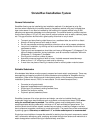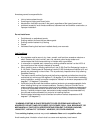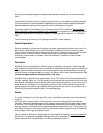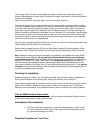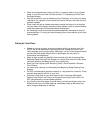
Armstrong cannot be responsible for:
• joint or texture show-through
• tunneling and ridging over board joints
• discoloration from stain sources in the panel, regardless of the type of panel used
• problems caused by local climate conditions, basement wall and subfloor construction, or
improper installation
Do not install over:
• Particleboard, or waferboard panels
• Existing resilient tile floors that are below grade
• Existing cushion-backed vinyl flooring
• Carpet
• Hardwood flooring that has been installed directly over concrete
Job Conditions
• All substrates must be sound, dry, clean, smooth, and free from excessive moisture or
alkali. Remove dirt, paint, varnish, wax, oils, solvents, other foreign matter and
contaminates that could cause staining or interfere with a good bond.
• In renovation or remodel work, remove any existing adhesive residue* so that 100% of
the overall area of the original substrate is exposed.
• When installing over an existing resilient floor, use S-199 One-Part Embossing Leveler or
S-194 Patch, Underlayment & Embossing Leveler/S-195 Underlayment Additive to fill and
smooth any embossing in the old floor. This is particularly important when fully adhering
StrataMax flooring.
• The area to receive resilient flooring and the flooring materials and adhesives should be
maintained at a minimum of 65 degrees F (18 degrees C) for 48 hours before installation,
during installation, and 48 hours after completion. Maintain a minimum temperature of 55
degrees F (13 degrees C) thereafter.
• Verification must be made that subfloor moisture levels do not exceed acceptable limits
when installing flooring over concrete subfloors. Conduct a Calcium Chloride Test to
measure subfloor vapor transmission levels prior to installation. Armstrong recommends
a maximum acceptable moisture emission level of 3lbs/1000 sq.ft/24 hrs. for StrataMax
flooring. If subfloor moisture vapor transmission levels exceed the recommended limit,
the concrete must be allowed to dry out prior to installing the floor.
• Radiant heated substrates must not exceed a maximum surface temperature of 85
degrees F (29 degrees C)
* WARNING: EXISTING IN-PLACE RESILIENT FLOOR COVERING AND ASPHALTIC
ADHESIVES. DO NOT SAND, DRY SWEEP, DRY SCRAPE, DRILL, SAW, BEADBLAST, OR
MECHANICALLY CHIP OR PULVERIZE EXISTING RESILIENT FLOORING, BACKING,
LINING FELT, ASPHALTIC "CUTBACK" ADHESIVE, OR OTHER ADHESIVE.
These existing in-place products may contain asbestos fibers and/or crystalline silica.
Avoid creating dust. Inhalation of such dust is a cancer and respiratory tract hazard.



